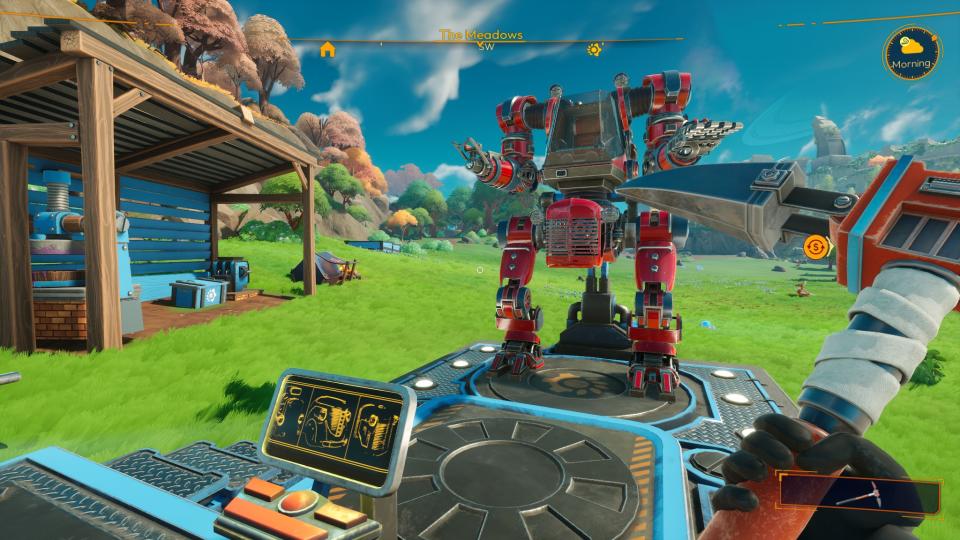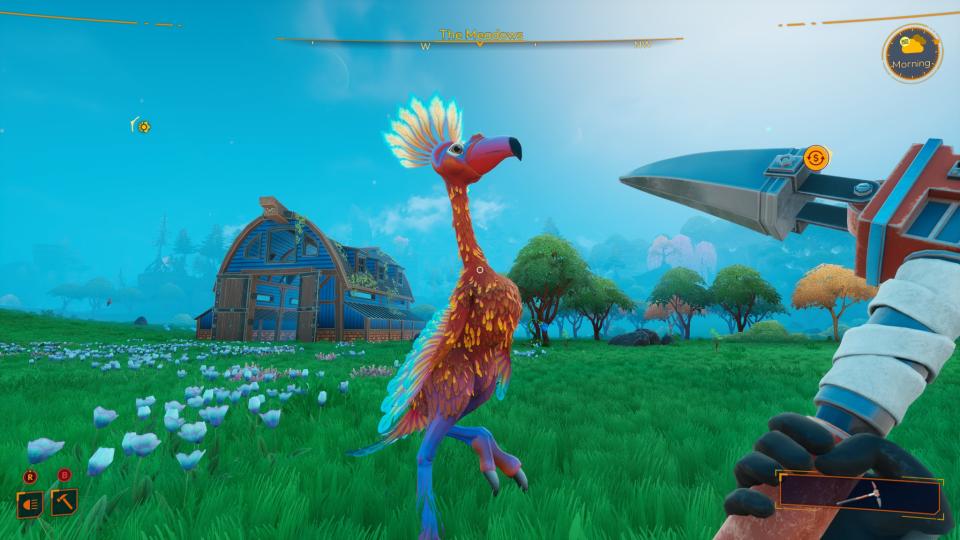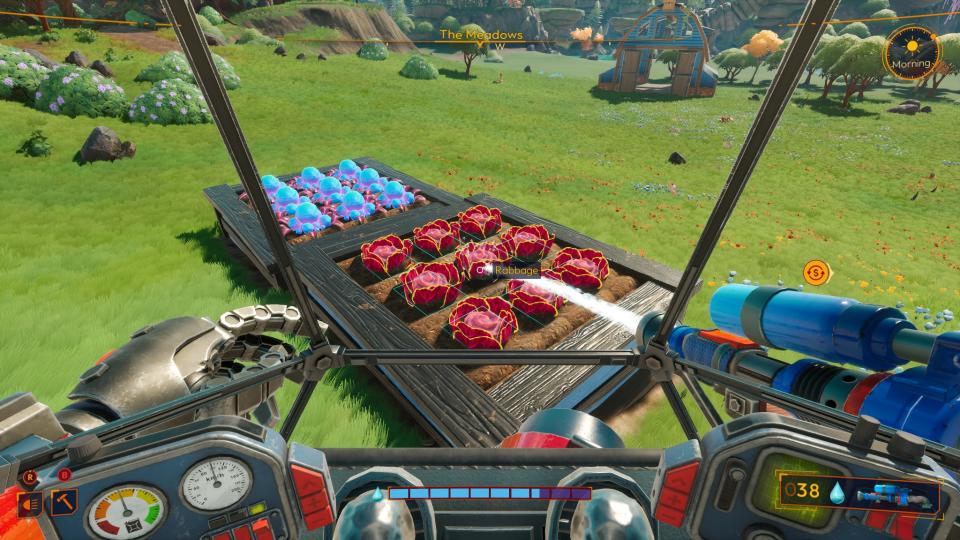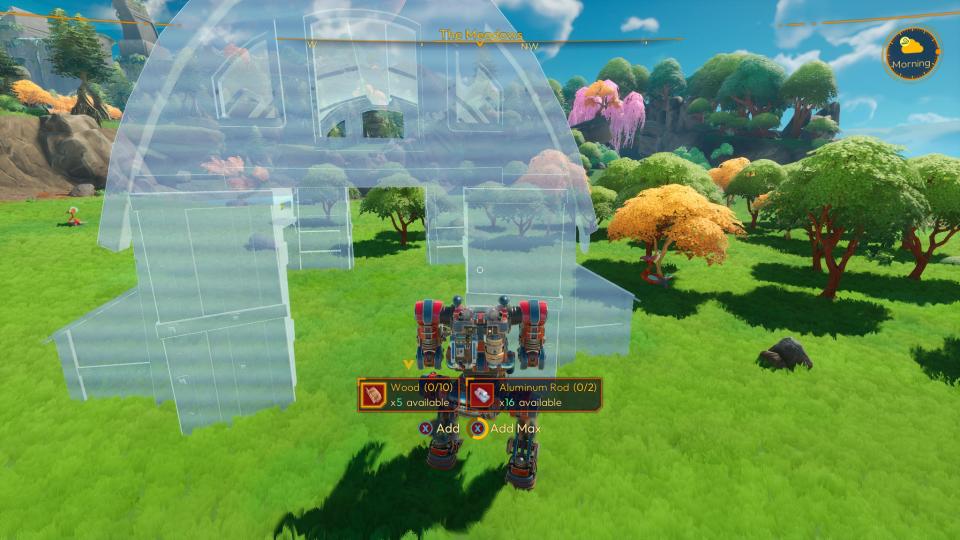I made up my mind about loving the cozy homesteading mech alien game Lightyear Frontier as soon as I saw its first trailer. After playing the demo in this week’s Steam Next Fest, and talking to Frame Break CEO Joakim Kopriva Hedström, I haven’t changed my mind. But it turns out it’s not the week-stealing farm sim obsession I’d hoped for. Instead, I found a well-oiled and approachable open-world to-do list that could appeal to job simulator players as well as my casual farming friends.
Lightyear Frontier begins when I land on a planet and, guided by a robot assistant in my ear, retrieve my giant mech suit. It’s an instant delight to zip around in my giant red machine as I swing to hit trees with my spiked saw arm and use my gatling-looking sprout gun to suck new saplings into the dirt. Its shiny primary color gives me a playful glow of youth (in a good way) and the jaunty synth and acoustic guitar soundtrack had me humming within minutes.


Just after getting used to my pilot multi-tool, I’m setting up a base of operations for myself with a tent, campfire, storage chest, and crop planting plots. Despite how that sounds, this is not a game of survival. I don’t have to worry about feeding myself, just the local wildlife.
Lightyear Frontier calls itself an “open-ended peaceful farming adventure”, which means I’m building devices to process resources into materials, upgrading my mech-gathering capabilities, and exploring the map (designed by hand, not generated) to revive the biomes. which has been taken over by a mysterious purple goop.
Not wasting space
It’s that environmental angle that drew me to Lightyear Frontier in the first place. As much as I love farm sims and crafting games, they often encourage dominance. In Stardew Valley I clear entire properties of trees and replace them with expensive fruit crops and crafting games invite me to build sprawling wooden monuments to industry and ego.
While those games can be elevated, Hedström tells me that Frame Break wanted a different kind of positive message in Lightyear Frontier—one that doesn’t encourage exploitation. “You want to have this connection with nature,” he says. “You’re discovering this great new planet and you don’t want to destroy it; you want to be a part of it.”


One of my initial goals is to find the nearby Pine Heights area, a barren and craggy lifeless biome, and restore it by filling my mechanic’s water tank and using an irrigation hose arm to break up areas of purple goo on the ground. Power washing gunk with an overhead completion percentage was probably the main bit that got me thinking about job sims, I admit.
You’re coming to this great new planet and you don’t want to destroy it; you want to be a part of it.
After I find all the offending globes and achieve 100% restoration, the area where it was sparse grows grass and sprouts new tree leaves. I can now find aluminum and red crystals to mine and use in new buildings. Animal life also returns – some of them monstrous “ratscallions” with fleshy proboscis noses and bipedal feet – waiting for me to make food to offer them. A stream of some wild “rabbit” (alien red cabbage, it seems) that I pull up with my vacuum cleaner attachment and bring back to plant in my garden plots.
That feedback loop didn’t always come so naturally, says Hedström. Earlier in development, Lightyear Frontier was more punitive, with an eco score and other measures meant to show players their impact, a system he describes as “take care of nature or bad things will happen.” That was a lot more stressful than it was fun for the players, it turns out. Instead, Lightyear Frontier focuses on positive feedback where “if you do good things, good things will happen to you.”
Unlike so many farming sim games, the trees don’t just grow back on their own, for example, which is part of this ‘do good for your own good’ ethos. “Players naturally start planting the nearby tree groves instead of having to venture much further,” explains Hedström.


I can feel that I am already in the exhibition as I start saw-arming through a grove of trees I camped near the meadow area. As I notice them shrinking, I pull out my sprout gun and plant new seeds into the ground nearby. It’s far more immediate gratification than any real reforestation project would provide, but as you’ve probably gathered from the mechs, Lightyear Frontier isn’t committed to being realistic.
When designing my house, the building system does not go very deep. It uses pre-made structures like the barn and farmhouse, not individual building blocks to play with. Instead I unlocked decoration and other processing machines to customize the exterior of my interplant home. I can’t bring animals back to live on my farm yet, but that’s on the map for early access, Hedström confirms.
Later in the game, there are a few more alien biomes to explore and a story where you’ll “scatter clues to find the various environments of the planet and find lost information,” says the Lightyear Frontier store page. That story is hinted at by a mysterious metal door that lights up when I finish restoring Pine Heights.


Lightyear Frontier strikes me as a game that takes a light touch with many systems that farming, crafting or other survival games go deep into. The build is pretty basic, as described, there’s a simple “economy” screen that shows likely price changes for individual resources I can sell, weather and occasional hazards, and farming but not the passing seasons. This is all very low pressure in a way that makes me believe it will be an ideal Game Pass game, especially with four player co-op at launch.
The Lightyear Frontier demo is currently available on Steam as part of Next Fest until February 12. It will launch into early access on March 19 and will also be included in Game Pass.